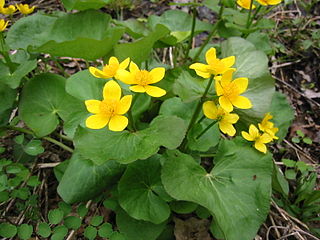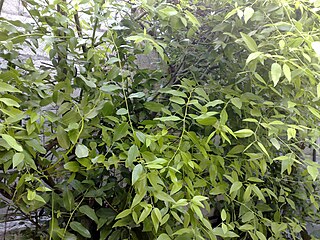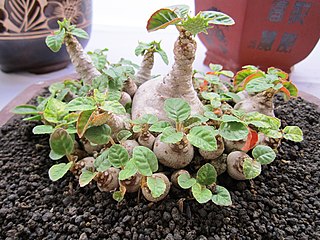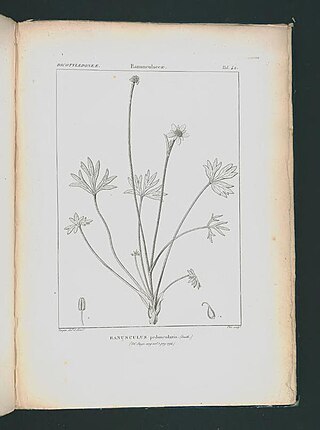
Alstroemeriaceae is a family of flowering plants, with 254 known species in four genera, almost entirely native to the Americas, from Central America to southern South America. One species of Luzuriaga occurs in New Zealand, and the genus Drymophila is endemic to south-eastern Australia.

Caltha palustris, known as marsh-marigold and kingcup, is a small to medium size perennial herbaceous plant of the buttercup family, native to marshes, fens, ditches and wet woodland in temperate regions of the Northern Hemisphere. It flowers between April and August, dependent on altitude and latitude, but occasional flowers may occur at other times.

Caltha is a genus of rhizomatous perennial flowering plants in the family Ranunculaceae, to which ten species have been assigned. They occur in moist environments in temperate and cold regions of both the Northern and Southern Hemispheres. Their leaves are generally heart-shaped or kidney-shaped, or are characteristically diplophyllous. Flowers are star shaped and mostly yellow to white. True petals and nectaries are missing but the five or more sepals are distinctly colored. As usual in the buttercup family there is a circle of stamens around free carpels.

Codiaeum variegatum is a species of plant in the genus Codiaeum, which is a member of the family Euphorbiaceae. It was described by Carl Linnaeus in 1753. It is native to Indonesia, Malaysia, Australia, and the western Pacific Ocean islands, growing in open forests and scrub.

Maytenus magellanica is a small evergreen tree from the genus Maytenus, up to 5 meters (16 ft), in the Celastraceae. It grows in southern Argentina and Chile from 36ºS to Cape Horn (56ºS).

Coreopsis basalis, the golden-mane coreopsis, is a North American plant species in the sunflower family. It is native to the southeastern and south-central United States from Texas to the Carolinas. Isolated populations have been reported from Connecticut, Illinois, and California.

Litsea glaucescens, also called Mexican bay leaf, is an evergreen tree or shrub 3–6 metres (9.8–19.7 ft) high in the genus Litsea belonging to family Lauraceae. It is native from southern North America, mostly in Mexico. Distributed by Mexico and Central America.

Solanum villosum, the hairy nightshade, red nightshade or woolly nightshade, is a sprawling annual weed in Europe, western Asia, northern Africa, North America, and is also naturalized in Australia.

Dorstenia foetida, also known as grendelion, is a succulent plant in the genus Dorstenia, which is native to Eastern Africa and Arabia. It is a very variable species with a wide distribution.

Caltha natans is a species of flowering plant in the buttercup family. It goes by the common name floating marsh marigold.

Ranunculus peduncularis is a large perennial buttercup that grows in Patagonia on the margins of woods, scrubs and along streams, with long stems and deeply divided leaves. In the wild it flowers from spring to summer.
Caltha appendiculata is a perennial herb plant found in several countries of South America.

Caltha dioneaefolia is a dwarf perennial herb, of the Buttercup Family (Ranunculaceae) with apparently seated pale yellow flowers with about seven stamens and two to three free carpels and leaves that are reminiscent of those of the Venus flytrap, but very small and with leaflike appendages on the leaf. C. dioneaefolia occurs in the southern Andes of Chili and Argentina, including on Tierra del Fuego and Hermite Island.

Caltha novae-zelandiae, commonly known as New Zealand marsh marigold or yellow caltha, is a small, perennial herbaceous plant belonging to the family Ranunculaceae, that grows in open vegetations in mountainous areas, and is endemic to New Zealand.

Caltha obtusa, commonly known as white caltha, is a small, perennial herbaceous plant belonging to the family Ranunculaceae, that grows in open vegetations in mountainous areas, and is endemic to New Zealand’s South Island.
Caltha introloba, commonly known as the alpine marsh-marigold is a small hairless, perennial alpine herb, that is endemic to the alpine regions of Australia and Tasmania.
Caltha scaposa is a low, perennial herb with one or two yellow hermaphrodite saucer-shaped flowers. This marsh-marigold species belongs to the buttercup family, grows in moist alpine fields and is native to the eastern Himalayas and the mountains on the eastern margin of the Tibetan highland.

Berberis ilicifolia, sometimes called holly barberry or holly-leaved barberry is a medium to high, spiny shrub belonging to the barberries in the family Berberidaceae. The local name in Chile is Chelia. It has ovate leaves with a few teeth that end in spines, reminiscent of holly leaves. Its orange flowers grow with three to seven together, which later produce globose blue-black berries. The species originates south of 40ºS in Argentina and Chile, where it grows in Nothofagus woods. Flowers are present from August to December, while ripe berries are available between November and March.

Rumex fueginus, known as American dock, golden dock, and Tierra del Fuego dock, is a flowering plant in the family Polygonaceae. Rumex fueginus was first formally named by Rodolfo Armando Phillipi. Rumex fueginus is native from Canada in northern North America to Tierra del Fuego at the southern tip of South America. It has previously been considered a subspecies or variety of Rumex maritimus, a Eurasian species.

Myosotis albiflora is a species of flowering plant in the family Boraginaceae, native to southern Chile and Argentina. This species was described by Joseph Banks and Daniel Solander in Joseph Dalton Hooker's 19th century work Flora Antarctica. Plants of this species of forget-me-not are perennial and have white corollas. It is one of two native species of Myosotis in southern South America, the other being M. antarctica.
















